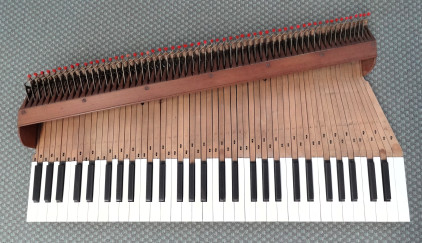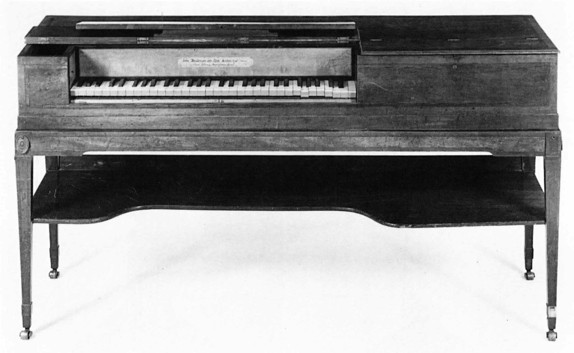
CAREY BEEBE
Original Instrument ReportCopyright © 2021 CBH |
 CAREY BEEBE |
| Square pianoforte by John Broadwood and Son, London 1796 |
Maker
Scotsman John Broadwood (1732–1812) moved to London in September 1761 to apprentice with harpsichord maker Burkat Shudi (1702–1773). Marrying Shudi’s daughter in 1769, he became a partner in the business in 1770, and its effective head from 1771. Broadwood’s Journal first mentioned square piano sales in 1778. (Cole believes the square piano in Fenton House, Hampstead, signed Johannes Broadwood Londini Fecit 1774 was built by Christopher Ganer.) In 1795 he took his son James Shudi Broadwood into partnership, and the instruments from then until 1808 were signed John Broadwood and Son. In the mid-1790s when this instrument was built, their annual output of square pianos numbered about four-hundred. While Broadwood ceased production of square pianos in 1866, their output of grands and uprights continued. The business underwent several permutations and survived until the 1990s.
Further discussion
Boalch, Donald H Makers of the Harpsichord & Clavichord 1440–1840 Third Edition, Oxford 1995, pp25,26
Clinkscale, Martha Novak Makers of the Piano 1700–1820 Oxford University Press, Oxford 1995, pp30–56
Clinkscale, Martha Novak Makers of the Piano Volume 2 1820–1860 Oxford University Press, Oxford 1999, pp47–61
Cole, Michael Broadwood Square Pianos Tatchley Books, Cheltenham 2005, p122
Wainwright, David Broadwood by Appointment Quiller Press, London 1982
Inscriptions
The nameboard is inscribed John Broadwood and Son London 1796 Patent / Great Pulteny Street Golden Square. The inked serial No 3291 is found in the usual position on the rear wrestplank to the right of the treble-most tuning pin, as 3291 in pencil in the middle of the reverse of the nameboard, in faded pencil on the bottom of the keybed, and in pencil on the front rail of the table stand. There is an illegible signature on the top key behind the balance mortise. There is a pencil note on the treble keyframe stile Murray / 3386 and the same number appears in pencil on the front face of the front rail. The underside of the top key is inscribed in ink Restored by WF Bradshaw / Jan 1987 Woollahra / Sydney / Australia.
Each pair of tuning pins is identified by inked letters in front. The original engraved troubleshooting label in English and French is attached to the spine above the wrestplank in the bass.
Keyboard
The five-octave keyboard has sixty-one notes, FF–f''', all on a single keyframe. The Stichmaß is 489mm. Each lime keylever is numbered in ink behind the balance pins. If the string gauges were originally marked on the keylevers, these markings are no longer visible. The keys are guided by front pins. The balance rail and front rail are oak and the backrail pine. The ivory-covered naturals have 42.5mm heads with two score marks (one at the join, the other a little over 3mm in front) and 96mm tails. The ivory heads are about 2.5mm thick at their fronts, and taper in thickness with the tails to about 1mm towards the rear of the tails. The moulded sycamore keyfronts and ivory covers make the natural heads 20mm deep. The beveled solid ebony sharps are 9.5–11.5mm wide, and 80–84mm in length.
Action
The action is the single English action with brass peacock underdampers. It may have been intended for, or come from, a slightly later instrument as the serial numbers on the action (3386) do not match the case and stand (3291). This was a changeover period with a minor action redesign. As the hammers of the existing action rely solely on their leather hinges, the second instruction on the engraved troubleshooting label [see below] is superfluous: It was only required for the slightly earlier action whose hammer shanks were mortised and undercut for penetration by a vertical brass pin, restricting any possible sideways motion. The complete action and leather hammer coverings are in good condition, with original keyframe cloths. There are no pedals or hand stops so any tonal variations afforded by those devices are not possible.
 CAREY BEEBE |
| Keyframe and action removed from the instrument |
Stringing
The instrument is bichord throughout, with open wound strings for the bottom octave. The scaling (c'') is 286mm. The hitchpin loops of the stringing done as part of the restoration in the instrument’s recent past [see below] were elegant, but the untidy wrappings indicate that at some later stage, the original Broadwood tuning pins were sadly discarded in favor of inappropriate short modern ø5.4mm tuning pins with holes.
Materials
The soundboard is spruce and both bridge and nut beech. The case rim is veneered in mahogany. The spine exterior is not veneered. The remainder of the case exterior including the lid is veneered in the usual manner of these popular instruments, with central mahogany panels, separated from the satinwood perimeter by a narrow band of mahogany with chevron stringing inside and plain stringing outside. The flat bottom moulding is mahogany.
The three faces of the keywell are more simply veneered, with the purpleheart perimeter of each face separated from the central satinwood panel by rosewood and sycamore stringing. The nameboard has an inlaid sycamore elongated cartouche containing the inked inscription.
The three panels of the solid mahogany lid measure 11mm thick with the entire exterior veneered as though one piece to match the case. The main lid is supported by two mahogany lid sticks, each screwed to the case interior. The three panels of the lid enable three possible playing positions from loud to soft: Fully open, main lid closed but right flap open, and main lid closed with right flap closed. (Being hinged to the keyboard flap, the fallboard prevents the instrument from being played if the keyboard flap is closed.) When the main lid is closed, a music book can lean against the fallboard with the bottom of the music supported by a ledge on the keyboard flap interior. The instrument retains its original brasswork including hinges, three lid hooks and eyes. There is a lock on the fallboard, although its escutcheon and key were missing.
The scantlings are about 19.5mm on all case sides, including veneers. The case without lid or bottom moulding measures 1572mm long, 534mm wide and 222mm deep.
The piano rests on its original square tapered leg table stand with brass casters and integral music shelf. There is a moulding on the two sides and front, so the instrument must slide into the stand from the spine, and be firmly located by dropping onto two oak dowels set in the stand’s front rail. The legs are veneered with a central stripe on each face and the usual stringing separation from the corners. There are cast brass bolt covers on the visible six corners of the stand.
The playing surface of the natural keys is 743mm from the floor. The lid for the toolbox at the bass end of the keyboard can be lifted by a folded leather pull tab, and can be fastened by a simple turnbuckle. Small blocks glued to the case interior once supported the missing original dust cover.
Provenance
The piano was purchased from the late W.F. Bradshaw, eminent Sydney antique dealer of 96 Queen Street Woollahra, on 3 April 2007. Previously, it is believed to have been in the possession of a Justice of the Supreme Court of New South Wales whose family name began with “Q”. It is not known exactly when the piano first came into the hands of Bill Bradshaw, because it was seemingly passed in at £350 at the Sotheby’s Early Musical Instruments auction in December 1985.
Previous restoration work
The instrument was restored for Bill Bradshaw by Ian Watchorn in Melbourne in the late 1980s, when its badly cracked bridge necessitated soundboard removal and reinstatement. The repaired bridge with its very slightly different treble curve was reattached to the board, so signs remain of its original location. The piano was carefully restrung at that time with Malcolm Rose wire using the original tuning pins. The untidy wrappings around inappropriate short modern ø5.4mm tuning pins with holes when the piano came into my possession in 2007 indicated that the original tuning pins were discarded by a subsequent unknown and less-skilled technician who nonetheless reused the existing strings. These strings were measured and the total tension calculated to be 1147kg at A425: My new schedule gave slightly less 1092kg.
 CAREY BEEBE |
| Inscription on the 1796 John Broadwood and Son square pianoforte nameboard |
Literature
This piano does not appear in the Broadwood archives as its 1796 date predates the first porters book of December 1798. While there are also customer ledgers for Broadwood’s wholesale and retail customers from 1794 which give dates and details of financial transactions, the early customer ledgers only very rarely give any serial numbers.
 SOTHEBY’S |
| 1796 Broadwood square as pictured in Sotheby’s 12th December 1985 auction catalogue |
Sotheby’s Auction Catalogue: Early Musical Instruments London Thursday 12th December 1985, unpaginated:
[Lot] 108
A Square Piano by John Broadwood & [sic] Son, London,
1796 the satinwood nameboard with holly and stained
fruitwood stringing and mahogany crossbanding
inscribed on a boxwood plaque John Broadwood & [sic] Son,
London, 1796 Patent, Great Pulteney Street, Golden Square,
bearing the serial number H329 [sic], the mahogany case
with fruitwood, holly and kingwood stringing and with
satinwood crossbanding, bearing an original label in
English and French giving general maintenance
instructions, the five octave keyboard, FF to c3, with
ivory naturals and ebony accidentals, single action with
underdampers, length 5ft 2in. (157.5cm.) width 2015/16in
((53.1cm.) on frame stand with shelf stretcher
£700- 1,000
The instrument is not mentioned in Clinkscale’s Makers of the Piano 1700–1820 nor is known to appear in any other literature. The 1796 Broadwood square is #CEP-7401 in Clinkscale Online.
 CAREY BEEBE |
| English side of engraved troubleshooting label on spine interior |
Outline of Work
 |
| Download postcard. |
| Original Instrument Collection | |
| Site overview | |
| Harpsichords Australia Home Page |